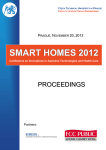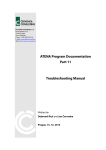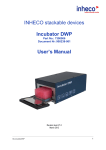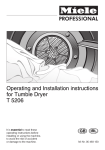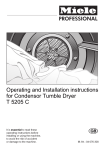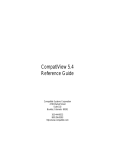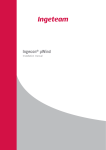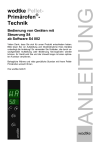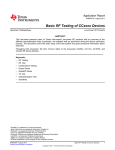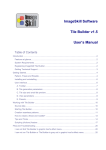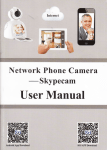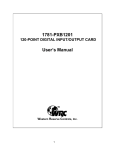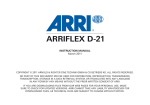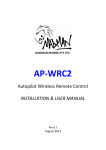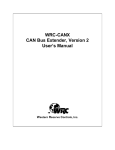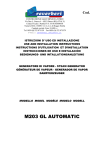Download User Guide - Water Research Commission
Transcript
TT 109/99 SANFLOW Ver 1.5 – USER GUIDE Development of a standardised approach to evaluate burst and background losses in water distribution systems in South Africa SOUTH AFRICAN WATER RESEARCH COMMISSION WRC Report No TT 109/99 ISBN 1 86845 490 8 June 1999 NFGUIDE.DOC i 29 June 1999 TT 109/99 SANFLOW Ver 1.5 – USER GUIDE NFGUIDE.DOC ii 29 June 1999 TT 109/99 SANFLOW Ver 1.5 – USER GUIDE SANFLOW South African Night Flow Analysis Model Version 1.5 (December 1998) USER GUIDE developed through SOUTH AFRICAN WATER RESEARCH COMMISSION (for free distribution and use within South Africa) Model Design and Documentation by Ronnie Mckenzie (Coding by Stephen Langenhoven) NFGUIDE.DOC iii 29 June 1999 TT 109/99 SANFLOW Ver 1.5 – USER GUIDE IMPORTANT PREFACE This document incorporates the user guide to the South African Night Flow Analysis Model (SANFLOW) which has been developed through the Water Research Commission (WRC) funded project titled “Development of a standardised approach to evaluate burst and background losses in water distribution systems in South Africa”. The SANFLOW program represents the first of several programs that are being developed through the WRC in order to assist water suppliers to manage and reduce their levels of unaccounted-for water. The programs are supplied free-of-charge through the WRC for use within South Africa and further details can be obtained from the WRC web site on: http://www.wrc.org.za. DISCLAIMER Every effort has been taken to ensure that the program and manual are accurate and reliable. Neither the Water Research Commission nor the program developers (R Mckenzie and S Langenhoven), shall, however, assume any liability of any kind resulting from the use of the program. Any person making use of this program, does so entirely at his/her own risk. COPYRIGHT The program and manual have been developed through the South African Water Research Commission (WRC). The WRC encourages the use and dissemination of information and software emanating from their research projects and the duplication and re-distribution of this software is therefore permitted. Similarly, duplication and redistribution of the user-manual is also permitted provided that due recognition is given to both the WRC and the developers. All copies of the software and manual should be attended by the above disclaimer. TECHNICAL SUPPORT The WRC does not provide technical support on the SANFLOW Model and any questions or problems associated with the program can be directed to the program developers at [email protected] or [email protected]. NFGUIDE.DOC iv 29 June 1999 TT 109/99 SANFLOW Ver 1.5 – USER GUIDE EXECUTIVE SUMMARY In 1996 the Water Research Commission (WRC) identified the need to control the level of unaccounted-for water in South Africa and initiated several studies to address various issues associated with leakage from potable water distribution systems. It was clear at the time that this would become a major issue as a result of proposed new legislation governing the supply of potable water through water distribution systems. One of the studies supported by the WRC was the “Development of a standardised approach to evaluate burst and background losses in water distribution systems in South Africa” with the aim of developing a new model based on the “Burst and Background Estimate” (BABE) techniques as applied in the water sector of the UK. The BABE philosophy is currently used in many parts of the world where it is widely recognised as a simple and pragmatic approach to the very complex and often confusing problem of determining leakage from potable water distribution systems. The resulting SANFLOW model was developed together with Mr Allan Lambert (Bristol Water Consultancy Services) who developed and refined the original BABE concepts. The model does not include all of the features of similar UK models but does incorporate several new features. The SANFLOW model is designed to help water suppliers to determine the level of leakage in a particular zone metered area (ZMA) from the analysis of recorded minimum night flows. It is a very simple and straightforward model requiring minimal data and will help water suppliers to identify key problem zones quickly and effectively. It is one of several tools that are available to assist water suppliers in managing their systems to reduce unaccounted-for water. NFGUIDE.DOC v 29 June 1999 TT 109/99 SANFLOW Ver 1.5 – USER GUIDE The project report is essentially a User Guide supporting the SANFLOW Model and is presented in six sections, details of which are as follows: • Section 1: Background • Section 2: Purpose of document • Section 3: Introduction to the BABE procedures • Section 4: Background to night flow measurements • Section 5: Using SANFLOW • Section 6: Acknowledgements. The document effectively provides the background and a comprehensive description of the BABE procedures on which the SANFLOW model is based. It also serves as a user-guide to the SANFLOW model and includes a tutorial section to assist new users in getting started with their first night flow analysis. While all efforts have been taken to ensure that the model is trustworthy and free from error, neither the developers nor the WRC accept any liability of any kind for losses or damages resulting from the use of the model. Anyone using the model does so entirely at his/her own risk. NFGUIDE.DOC vi 29 June 1999 TT 109/99 SANFLOW Ver 1.5 – USER GUIDE Table of Contents Page No. EXECUTIVE SUMMARY v 1. BACKGROUND.................................................................................................. 1—1 1.1. GENERAL ...................................................................................................................... 1—1 1.2. DIFFERENCES BETWEEN SANFLOW AND UK MODELS ......................................... 1—2 1.3. DATA REQUIREMENTS................................................................................................ 1—2 1.4. NEED FOR FURTHER RESEARCH ............................................................................. 1—3 2. PURPOSE OF DOCUMENT............................................................................... 2—1 3. INTRODUCTION TO BURST AND BACKGROUND ESTIMATE (BABE) PROCEDURES................................................................................................... 3—1 3.1. HISTORICAL BACKGROUND....................................................................................... 3—1 3.2. COMPONENTS OF THE BABE METHODOLOGY ....................................................... 3—5 3.3. WHAT ARE BURST AND BACKGROUND LEAKS ? .................................................... 3—6 4. BACKGROUND NIGHT FLOW MEASUREMENTS.......................................... 4—1 4.1. GENERAL ...................................................................................................................... 4—1 4.2. NORMAL NIGHT USE ................................................................................................... 4—2 4.3. BACKGROUND LEAKAGE............................................................................................ 4—5 4.4. CALCULATION OF BURSTS ........................................................................................ 4—6 4.5. EXAMPLE 1: DEMONSTRATING THE USE OF THE BABE PROCEDURES.............. 4—7 4.6. PRESSURE CORRECTION ........................................................................................ 4—10 4.7. EXAMPLE 2: USING THE PRESSURE CORRECTION FACTORS ........................... 4—12 5. USING SANFLOW.............................................................................................. 5—1 5.1. INSTALLING SANFLOW ............................................................................................... 5—1 5.2. RUNNING SANFLOW.................................................................................................... 5—2 5.3. BASIC FEATURES ........................................................................................................ 5—4 5.4. ADDING THE BASE DATA THROUGH THE CONSTANTS FORM.............................. 5—8 NFGUIDE.DOC vii 29 June 1999 TT 109/99 SANFLOW Ver 1.5 – USER GUIDE 5.5. ADDING THE VARIABLE DATA THROUGH THE VARIABLES FORM...................... 5—10 5.6. ADDING THE NIGHT-USE DATA THROUGH THE NORMAL NIGHT-USE FORM ... 5—11 5.7. RESULTS FROM SANFLOW ...................................................................................... 5—13 5.8. GRAPHS AND REPORTS ........................................................................................... 5—14 5.9. SENSITIVITY ANALYSIS............................................................................................. 5—15 6. ACKNOWLEDGEMENTS .................................................................................. 6—1 APPENDIX A: Program Variables APPENDIX B: Definition of Terms NFGUIDE.DOC viii 29 June 1999 TT 109/99 SANFLOW Ver 1.5 – USER GUIDE 1. BACKGROUND 1.1. GENERAL The UK water industry has been developing a standardised approach to leakage control since the early 1990s and has formalised the Burst and Background Estimate (BABE) approach. The BABE philosophy has been accepted and adopted in many parts of the world since it provides a simple and pragmatic approach to the very complex and often confusing problem of leakage from water distribution systems. The BABE approach has been shown to be valuable in solving many of the problems experienced when dealing with leakage from water distribution systems. As part of the BABE approach, various computer programs were developed in the UK by several of the large water companies. In some cases these programs were for internal use by the water company while in other cases they were available to other parties on a commercial basis. In most cases the software was developed around an EXCEL spreadsheet since EXCEL was the original development package used at the time of the various research initiatives. Commercial software based on the BABE principles is currently available through Welsh Water PLc, Bristol Water Plc, and also through various other water companies. In 1996 the Water Research Commission (WRC) identified the need to control the level of unaccounted-for water in South Africa and initiated several studies to address various issues associated with leakage from water distribution systems. It was clear at the time that this would become a major issue as a result of proposed new legislation governing the supply of potable water through water distribution systems. It has already supported the development of various products to assist water suppliers in meeting their commitments in terms of the new Water Act and Water Services Act. One of the studies supported by the WRC was the “Development of a standardised approach to evaluate burst and background losses in water distribution systems in South Africa”. The purpose of the study was to develop a new model to assist with the interpretation of night-flow data based on the BABE techniques. One of the key developers of the BABE techniques, Mr A Lambert, was part of the project team and with his assistance, the team were able to develop a user-friendly program in a relatively short space of time making use of research undertaken in the UK. The result of the study is the South African Night Flow Analysis Model (SANFLOW) which in many respects is similar to the equivalent UK model although there are several key and important differences. NFGUIDE.DOC 1—1 29 June 1999 TT 109/99 SANFLOW Ver 1.5 – USER GUIDE 1.2. DIFFERENCES BETWEEN SANFLOW AND UK MODELS The most important difference between SANFLOW and its UK counterparts is the fact that SANFLOW is not based on an EXCEL spreadsheet. Instead it is a full Windows application based on the Borland DELPHI package and therefore requires no additional software on the user’s computer. The UK based products generally require the user to have EXCEL available to run the leakage programs. The second main difference between SANFLOW and the UK programs is that SANFLOW has been designed in such a way that it is extremely simple to use and all of the detailed calculations are hidden from the main screen. The main screen therefore provides a clear and concise overview of the leakage in a particular zone. Details for any of the calculated values can be viewed by simply selecting the variable from the main task bar. A third and possibly the most useful difference between the models is the incorporation of a sensitivity analysis in SANFLOW. In all of the previous commercial versions of the BABE models, there was always a concern regarding the selection of certain process parameters or variables that could influence the overall leakage predictions. To establish if such variables had an important influence on the results, the user would normally have to change each variable individually and re-run the program. In the case of SANFLOW, a new feature has been added that allows the user to view (graphically) the significance of changing the various process parameters either individually or simultaneously. This feature adds a new dimension of reliability to the results from the model and addresses perhaps the most common criticism of the basic BABE approach. In summary, the SANFLOW model is based to a large degree on research and work undertaken in the UK. It started at the point where the UK research left off in 1996 and has taken the development to a new level of presentation and reliability. The equivalent commercial UK models are generally priced in the order of R5 000 compared to the SANFLOW Model which is available through the WRC free-of-charge. In this manner, the WRC hopes to encourage water suppliers to make use of a standard package for the assessment and interpretation of night-flow data as a means of reducing unaccounted-for water. 1.3. DATA REQUIREMENTS In order to run SANFLOW certain data are required for each zone to be analysed. Most of the data are readily available from most water suppliers, such as population, number of connections, length of mains, average zone pressure and details of any major water users NFGUIDE.DOC 1—2 29 June 1999 TT 109/99 SANFLOW Ver 1.5 – USER GUIDE etc. Other data required such as the various leakage coefficients and pressure correction coefficients, however, are not readily available in South Africa and in such cases, the suggested default values should be used. In this manner, the user can very quickly derive an estimate of the leakage in the particular zone and the facility is provided to test the sensitivity of the results against the values selected for the unknown variables. Although the default values have been derived from overseas data they have been tested in many other parts of the world, some with similar conditions to those experienced in South Africa. In most cases the default values will provide a realistic estimate of the overall leakage and the user will find that the results are not particularly sensitive to individual parameters. The user should remember that the model is designed to provide an estimate of burst leakage in a zone given minimal information. The data requirements are therefore very basic and the model is designed to provide a quick estimate of the leakage without undertaking a full distribution network analysis. It is therefore designed to identify the main problem zones in a distribution network where leakage is a serious problem after which more sophisticated techniques can be employed if necessary. 1.4. NEED FOR FURTHER RESEARCH The methodology used in SANFLOW is a very empirical method based on a large number of test results from the UK and elsewhere in the world. Despite the empirical approach, the methodology has been used with great success in many parts of the world including Europe, the Middle East, Malaysia, South America, Africa and the USA. Although the model can be used in its current form in South Africa by making use of the default parameter values, it is recommended that some additional research be undertaken to establish parameter values for specific South African conditions. Such research will form part of an ongoing process to improve the quality of the leakage estimates and to gain a greater understanding of the main processes involved in the leakage problem. In the South African context, the main area where research is required is in the estimation of the normal household night use. In view of the large variation in living standards encountered in South Africa, normal domestic night use is currently one of the most difficult components to estimate. Some clarity on this issue will be very useful for future leakage assessments. NFGUIDE.DOC 1—3 29 June 1999 TT 109/99 SANFLOW Ver 1.5 – USER GUIDE NFGUIDE.DOC 1—4 29 June 1999 TT 109/99 SANFLOW Ver 1.5 – USER GUIDE 2. PURPOSE OF DOCUMENT The purpose of this document is to provide details of the South African Night Flow Analysis Model (SANFLOW) which was developed with the support of the Water Research Commission. The program is one of several programs developed to help water suppliers manage their unaccounted for water (UAW) using the burst and background estimate (BABE) procedures developed by the UK water industry during the early 1990s. These procedures have since been used throughout the world and are rapidly gaining international acceptance as the standard approach to evaluating leakage levels in potable water supply distribution systems. The remainder of the document is divided into sections that provide the following information: SECTION 3: INTRODUCTION TO BURST AND BACKGROUND ESTIMATE (BABE) PROCEDURES This section provides details of the BABE procedures as developed by the UK water industry and explains the terms and terminology used in the South African version of the Night-Flows Model - one of the key software modules making up the BABE suite of programs. SECTION 4: BACKGROUND NIGHT FLOW MEASUREMENTS This section provides an overview of the SANFLOW model together with details of all parameters and variables used in the model. SECTION 5: USING SANFLOW This section provides an easy-to-follow step-by-step tutorial on the use of the SANFLOW model. NFGUIDE.DOC 2—1 29 June 1999 TT 109/99 SANFLOW Ver 1.5 – USER GUIDE NFGUIDE.DOC 2—2 29 June 1999 TT 109/99 SANFLOW Ver 1.5 – USER GUIDE 3. INTRODUCTION TO BURST AND BACKGROUND ESTIMATE (BABE) PROCEDURES 3.1. HISTORICAL BACKGROUND In 1991, a National Leakage Initiative was established in the UK by the Water Services Association and the Water Companies Association to update and review the guidelines concerning leakage control that had been in use since 1980. It was agreed by all organisations involved in potable water supply that the guidelines required updating in view of the considerable progress that had been made over the previous ten-year period. As a result of new water legislation, it became necessary for all water suppliers to demonstrate to the regulators that they fully understood their position on leakage. This did not imply that all water suppliers had to demonstrate the lowest achievable leakage levels, but simply that they were applying correct and appropriate economic and resourcing principals. To this end, it was agreed that all water suppliers would adopt a straightforward and pragmatic approach to leakage levels. This was achieved through the development of various techniques that became known as the Burst and Background Estimate (BABE) methodology. The BABE procedures were developed over a period of approximately four years by a group of specialists selected from several of the major water supply companies based in England and Wales. The group was instructed to develop a systematic and pragmatic approach to leakage management that could be applied equally well to all of the UK water supply utilities. The result of this initiative was a set of nine reports published by the UK Water Industry (WRc) on the subject of managing leakage. The nine WRc reports cover the following topics : Report A: Summary Report Report B: Reporting Comparative Leakage Performance Report C: Setting Economic Leakage Targets Report D: Estimating Unmeasured Water Delivered Report E: Interpreting Measured Night Flows Report F: Using Night Flow Data Report G: Managing Water Pressure Report H: Dealing with Customers Leakage Report J: Leakage Management Techniques, Technology and Training. NFGUIDE.DOC 3—1 29 June 1999 TT 109/99 SANFLOW Ver 1.5 – USER GUIDE The intention of the reports was not to be prescriptive, but to provide a “tool kit” to the water industry to enable the water supply manager to evaluate leakage levels and to manage the system. In order to address leakage it was considered necessary to first understand the various components making up the water balance for a typical water supply network. The previous approach as shown in Figure 3.1 was to consider three main components, namely: Authorised metered, authorised unmetered and the remainder which represents all unaccounted-for water, and is often referred to as the real and apparent losses. Further details on real and apparent losses are provided later in this section and are also shown in Figure 3.3. Real and Apparent Losses Authorised Unmetered Delivered Authorised Metered Delivered Figure 3.1: Traditional Water Balance. In view of the large portion of the traditional water balance that was usually represented by the real and apparent losses, the whole water balance approach was revised by breaking the balance down into smaller components that could either be measured or estimated. In this manner it was possible to gain a greater understanding of the different NFGUIDE.DOC 3—2 29 June 1999 TT 109/99 SANFLOW Ver 1.5 – USER GUIDE components and also of their significance to the overall water balance. A typical example of the BABE water balance is provided in Figure 3.2. It should be noted that the water balance need not be restricted to the components shown in this figure and conversely it can be split into a greater number of components or perhaps different components. Every system is different and it is the general approach that should be applied and not a specific and rigid framework. Figure 3.2: BABE Water Balance Approach. The BABE water balance approach has now been widely accepted worldwide and is also incorporated in much of the latest South African water legislation. It is not a highly technical or complicated approach; on the contrary, it is extremely simple and logical. The typical components that can be included in any particular water balance were established at the International Water Supply Association Workshop held in Lisbon in May 1997. The water balance components identified at the workshop are shown in Figure 3.3. It should be noted that the components shown in this figure also include the losses associated with the bulk water system as well as the purification system. For municipalities supplying only the water on the distribution side of the bulk supply system, many of the items shown in Figure 3.3 can be omitted. Similarly, in many of the municipalities in South Africa, the NFGUIDE.DOC 3—3 29 June 1999 TT 109/99 SANFLOW Ver 1.5 – USER GUIDE internal plumbing losses (LP) dominate the whole water balance although such losses are represented by only a small block in the figure. In such cases it may not be necessary to undertake a full and detailed water balance until the plumbing losses are under control. Figure 3.3: Recommended BABE Water Balance Components. Figure 3.3 provides a breakdown of the most important components that can be included in a water balance for a specific water supplier. It is important to note that the losses have been broken down into real and apparent losses. Real losses are those where the water has in fact left the system and has not been utilised in any way. If such losses can be reduced, the total water required by the supplier will also be reduced. Apparent losses on the other hand are simply “paper” losses that do not represent a loss from the system. They are usually due to illegal connections, and meter and billing errors. If such losses are eliminated, the total water required by the supplier may not change, however, the “unaccounted-for” component in the water balance will be reduced. In such cases certain other components such as “authorised metered” or even “authorised unmetered” will increase as the apparent losses are reduced. NFGUIDE.DOC 3—4 29 June 1999 TT 109/99 SANFLOW Ver 1.5 – USER GUIDE 3.2. COMPONENTS OF THE BABE METHODOLOGY In the development of the BABE techniques, it was eventually agreed that four principal issues concerning leakage management should be addressed. Models were developed for each issue and the four basic models are shown in Figure 3.4. Figure 3.4: Models Used in the BABE Procedures. This manual provides details of a South African version of the model used to interpret and process night flow data as indicated as one of the four main components in Figure 3.4. A model to analyse the components of losses and the annual water balance has also been developed (1998) through the Water Research Commission, and a model to address the economics of leakage management is currently under development. The fourth and final model to assist with pressure management has been approved by the Water Research Commission and development will commence early in 1999. In effect, South African versions of all four models should be available early in the year 2000. NFGUIDE.DOC 3—5 29 June 1999 TT 109/99 SANFLOW Ver 1.5 – USER GUIDE 3.3. WHAT ARE BURST AND BACKGROUND LEAKS ? In the course of the UK research into leakage management the leaks found in any water supply system were split into two types – those large enough to warrant serious attention with regards to location and repair and those too small to warrant such attention. The larger more serious leaks that warrant direct attention are referred to as bursts while those too small to deserve such attention are referred to as background leaks. The threshold between bursts and background leaks is not fixed and can vary from country to country. In the UK a threshold limit of 0.5 m3/h is used while in South Africa a lower limit of 0.25 m3/h is adopted. In other words : Leaks > 0.25 m3/h = Bursts < 0.25 m3/h = Background Leaks and Leaks In all water supply systems there are likely to be both bursts and background leaks since it is not possible to develop a system completely free from leakage. NFGUIDE.DOC 3—6 29 June 1999 TT 109/99 SANFLOW Ver 1.5 – USER GUIDE 4. BACKGROUND NIGHT FLOW MEASUREMENTS 4.1. GENERAL The measurement of background night flows is one of the most important actions that can be taken to identify leakage problems. It is often possible to identify many problem issues by simply looking at the minimum night flow. The minimum night flow is usually found to occur sometime between midnight and 4 am when the consumption in the network is at its lowest. Figure 4.1 provides a typical plot of the flow entering a zone metered area. Figure 4.1: Example of Flow entering a Zone Metered Area. Having logged a zone meter in order to establish the minimum night flow, it is then necessary to estimate how much of the night flow is due to burst pipes. In order to do this, a very simple and pragmatic approach was developed using the BABE procedures. In this approach, the minimum night flow is considered to consist of three main components namely: NFGUIDE.DOC 4—1 29 June 1999 TT 109/99 SANFLOW Ver 1.5 – USER GUIDE • Normal legitimate night use • Background losses • Burst pipes. This breakdown is shown in Figure 4.2 from which it can be seen that the normal use and background losses have been further divided into smaller components. Figure 4.2: Components of Minimum Night Flow. 4.2. NORMAL NIGHT USE In order to evaluate the magnitude of leakage from a zone (background and bursts) it is first necessary to quantify the level of genuine water use. As discussed previously the purpose of background night flow monitoring is to measure the minimum flow entering a zone at which time the genuine water use will be at its lowest and the leakage losses at their highest (due to the higher than average pressure). The genuine water use cannot be measured accurately since it includes a large number of small users; however, it can be estimated using guidelines derived from many surveys undertaken in various parts of the world. NFGUIDE.DOC 4—2 29 June 1999 TT 109/99 SANFLOW Ver 1.5 – USER GUIDE For the purpose of the SANFLOW program, the assessed night use has been split into three components namely: • • • Normal domestic night use Small non-domestic night use Larger users (recorded individually). The various components are discussed individually in the remainder of this section. Normal domestic night use Normal domestic night use represents the water used during the night in a household and is predominantly due to toilet use. Use of water for making coffee or tea represents a very small portion of the overall household use and is effectively ignored. In some areas of South Africa, garden watering or the filling of swimming pools may be of importance, however, in most cases such water use is minimal between the hours of 00:00 and 04:00 when the night-flow monitoring is undertaken. Experience in various parts of the world has shown that approximately 6% of the population are active (POPACT) during each hour and that the water use is in the order of 10 l /head.h (POPUSE). POPACT is expressed as a percentage of the population (POP) and should not be confused with the number of properties. The value of POPUSE is based on a standard 10 l toilet cistern and may vary from one country or region to another. The normal household night use is therefore easily estimated from the product of the active population (i.e. POPACT * POP) and the average use per hour (POPUSE). HNORUSE = (POPACT * POP) * POPUSE From various studies undertaken in different parts of the world it is suggested that the normal household use is based on either 1.7 l per household per hour or 0.6 l per person per hour (WRc, Report E). Small non-domestic night-use The small non-domestic night use is more difficult to evaluate and depends to a large extent on the type of businesses being run in the zone metered area. Although each small non-domestic user is metered individually it is impractical to record each of the meters during the night flow exercise. Instead the users are lumped into various categories and a typical night use is assumed for the group. For example, there may be several all-night garages or all-night cafes where the unit use is relatively small although when added together the total use may be significant. NFGUIDE.DOC 4—3 29 June 1999 TT 109/99 SANFLOW Ver 1.5 – USER GUIDE A range of typical night use values for various different commercial enterprises has been produced (WRc, Report E) based on extensive studies undertaken overseas. All properties using more than 500 l/h have been excluded from the analysis since these are considered individually and the meters at each user are monitored individually. Details of the suggested values are provided in Table 4.1. Table 4.1 Average Values of Night Flow Delivered to Different Types of Non- household, Grouped by Similar Average Use (from WRc, Report E) Group Sample Number Average per Average for all size active active properties property (l/prop⋅h) (l/prop⋅h) A. 123 16 7.0 0.9 2013 606 20.5 6.2 505 244 26.0 12.6 205 79 53.0 20.5 33 25 80.0 60.6 Unmanned fire/police stations, telephone exchanges, banks, church/chapels, gardens, water/sewage treatment works. B. Shops, offices, craft centres. Laundrettes, depots, large domestic property, guest houses, garage / filling stations, touring caravan sites, farms, smallholdings and cattle troughs. C. Hotels, schools/colleges, cafes/restaurants, public houses, social halls, residential caravan sites, livery stables. D. Hospitals, factories (food and manufacturers), public toilets, works sites E. Old people’s homes, small mines and quarries. An alternative for nursing homes and hospitals is 2.5 l/resident⋅h NFGUIDE.DOC 4—4 29 June 1999 TT 109/99 SANFLOW Ver 1.5 – USER GUIDE Large non-domestic users In some zone metered areas, it is often found that there may be one or more large water consumer whose consumption can influence the night flow analysis. In such cases it is necessary to meter the consumer individually to determine how much water has been used during the night flow exercise. Consumers falling into this category would include airports, large hotels, breweries, swimming pools, etc. 4.3. BACKGROUND LEAKAGE Background leakage is the cumulative leakage from all relatively small leaks and seepage that are individually less than 250 l/h at 50 m of pressure. Such leaks occur from valves, joints, hydrants, stop-taps, meters, dripping taps, toilet cisterns, roof tanks etc. Individually such leaks are generally uneconomic to find and repair with the result that background leakage is accepted as a fact of life within certain limits. In general, background leakage can be split into three main components namely: • Background leakage from mains (BLMAIN) • Background leakage from connections (BLCONN) • Background leakage from installations (BLINST) Background leakage from mains (BLMAIN) There will always be some Background Leakage from any distribution system, some of which occurs from the water mains. Small leaks often occur at the pipe joints or from small cracks or holes in the pipes and the magnitude of the leakage is dependent upon the condition of the infrastructure and the operating pressure. For the purpose of the background night flows model, all process parameters are given at the standard operating pressure of 50 m with the result that the parameter describing the background leakage from mains (BLMAIN) varies only with the condition of the infrastructure. Suggested values from the WRc Report E indicate an average value of 40 l/km of mains per hour with a range of ∀ 50 % ( i.e. 20 l/km⋅h to 60 l/km⋅h). Background leakage from connections (BLCONN) Poor workmanship coupled with general wear and tear often results in leaks from pipe connections. In general there will be one pipe connection to each property and the background leakage from connections (BLCONN) is therefore expressed as an average loss per connection where the number of connections is usually estimated directly from NFGUIDE.DOC 4—5 29 June 1999 TT 109/99 SANFLOW Ver 1.5 – USER GUIDE the number of properties. Connection leakage is considered as the leakage occurring from the connection at the water main to the water meter at the property or to the property boundary in cases where no meters exist. In most water distribution systems, the connection losses are often the major source of loss from the system. Suggested values of background leakage from connections are provided in the WRc Report E as 3 l per property per hour with a range of ∀ 50 % (i.e. 1.5 l/prop⋅h to 4.5 l/prop⋅h) depending on the condition of the infrastructure. Background leakage from installations (BLINST) The installation refers to all pipe-work, plumbing, fittings and fixtures both inside and outside the building located on the consumer side of the billing meter. It does not include the meter that generally remains the property of the water supply utility. A certain portion of background leakage occurs on the individual properties from either the pipe entering the dwelling from the water meter or from the various plumbing fittings inside the building. In most cases such leakage will be lower than that occurring from the mains connection (as discussed in the previous section). In South Africa, however, there are occasions where the leakage from the installations is dominant and in fact represents the largest form of leakage from the system. Unless more reliable information is available to suggest higher (or lower) leakage rates, the value recommended in the WRC Report E (Table 4.1) is 1.0 l per property per hour with a range of ∀ 50 % (i.e. 0.5 l/prop⋅h to 1.5 l/prop⋅h) depending on the condition of the infrastructure. The leakage is usually assumed to be equally divided between the pipe from the meter to the building and the internal plumbing fittings. 4.4. CALCULATION OF BURSTS Having measured or estimated the various components of normal night use and background night use, the two figures are added together and then subtracted from the measured minimum night flow. The difference is the unexplained losses that are attributable to either unreported bursts or to errors in the assumptions made during the calculation. The possibility of errors in the assumptions will be dealt with separately and the remainder of this section will consider the difference to be leakage. NFGUIDE.DOC 4—6 29 June 1999 TT 109/99 SANFLOW Ver 1.5 – USER GUIDE 4.5. EXAMPLE 1: DEMONSTRATING THE USE OF THE BABE PROCEDURES To demonstrate the use of the BABE procedures in helping to establish the level of leakage in a particular zone metered area, it is easier to make use of a simple example. In the first example a case will be used where the average zone night pressure is at 50 m which is the base pressure where no pressure correction factors are required. The base data for the example are provided in Table 4.2. Table 4.2: Base Data for Night Flow Example 1 Description Value Length of mains 9 300 m Number of connections 600 Number of properties 672 Estimated population 3 000 Average zone night pressure (AZNP) 50 m Measured minimum night flow (MNF) 14.4 m /h 3 Before the night flow can be examined it is necessary to decide on the values of the various loss parameters to be used in the analysis. Normally default values are adopted unless the person undertaking the analysis has some indication of alternative values based on previous experience. Items that can be taken into consideration when determining the loss parameters, will include, pipe material, age, ground conditions, quality of workmanship, etc. For this example the values given in Table 4.3 were selected. Table 4.3: Default Loss Parameters for Night Flow Example 1 Description Value 40 l/km⋅h Background losses from mains Background losses from connections 3 l/connection⋅h Background losses from properties 1 l/connection⋅h % of population active during night flow exercise 6% Quantity of water used in toilet cistern 10 l Number of small non-domestic users 30 Average use for small non-domestic users 3 Use by large non-domestic users NFGUIDE.DOC 50 l/h 1.2 m /h Background losses pressure exponent 1.5 Burst/leaks pressure exponent 0.5 4—7 29 June 1999 TT 109/99 SANFLOW Ver 1.5 – USER GUIDE Having established the default loss parameters it is now possible to estimate both the normal night use and the background leakage. The respective calculations are provided in Table 4.4 and Table 4.5. Table 4.4: Estimation of Normal Night Use for Night Flow Example 1 Description Calculation Value 3 3 000 @ 6%/h @ 10 l 1.8 m /h Small non-domestic use 30 @ 50 l/h 1.5 m /h Large non-domestic use 1 @1.2 m3/h 1.2 m3/h Domestic night use 3 3 Total normal night use 4.5 m /h Table 4.5: Estimation of Background Leakage for Night Flow Example 1 Description Calculation Mains losses 9.3 km @ 40 l/km⋅h 0.37 m3/h 600 @ 3 l/connection⋅h 1.80 m /h 672 @ 1 l/property⋅h 0.67 m /h Connection losses Property losses 3 3 2.84 m3/h Total background leakage at 50 m pressure Pressure correction factor Value (50/50)1.5 1.00 3 Total background leakage at 50 m pressure 2.84 m /h It should be noted that a pressure correction factor is indicated in the above table. In the case of this example the operating pressure is known to be 50 m which is considered to be the standard pressure. At standard pressure, no pressure corrections are required and it can be seen that the pressure correction factor is calculated to be 1.0 (i.e. no change). The topic of pressure correction is discussed in the next section after which the same example is recalculated at a different operating pressure. Now that the two use components have been estimated, it is possible to calculate the difference between the measured minimum night flow and the estimated legitimate use – note that background losses are considered to be legitimate since they cannot be eliminated completely from any system. Table 4.6 provides the calculation that identifies the level of unexplained leakage in the given zone metered area. NFGUIDE.DOC 4—8 29 June 1999 TT 109/99 SANFLOW Ver 1.5 – USER GUIDE Table 4.6: Estimation of Unaccounted-for Leakage in Night Flow Example 1 Description Value 3 Expected background leakage 2.84 m /h Expected normal night use 4.50 m /h Total expected night use 7.34 m3/h 3 14.40 m3/h Measured minimum night flow 3 Unaccounted-for leakage (14.40 – 7.34) 7.06 m /h As can be seen from the table, it is estimated that in this example the unexplained leakage is in the order of 7 m3/h. Equivalent service pipe bursts In order to compare leakage levels in different zones, it is often convenient to convert the unexplained leakage to an equivalent number of service pipe bursts. This is a convenient unit since most leakage detection teams have a good understanding of what a service pipe burst looks like and can usually judge leaks in relation to a service pipe burst. This also eliminates the problem of comparing unexplained leakage between two zones with different pressure. For the purpose of this comparison, an equivalent service pipe leak is considered to be 1.6 m3/h at the standard pressure of 50 m. In this manner the unexplained leakage shown in the previous table can be equated to a number of service pipe leaks, as shown in Table 4.7. Table 4.7: Estimation of Equivalent Service Pipe Bursts in Night Flow Example 1 Description Calculation Value 3 Unaccounted-for leakage 7.06 m /h Standard equivalent service pipe burst (@ 50 m) 1.60 m3/h Pressure correction factor for bursts (50/50) 1.00 1.00 * 1.60 m3/h Leakage from one equivalent service pipe burst Expected number of equivalent service pipe bursts 0.5 3 3 7.06 m /h / 1.60 m /h 1.60 m3/h 4.4 From this example it can be seen that there are approximately 4 equivalent service pipe leaks in the zone. In reality there may be 5 or 6 smaller leaks or even a single large leak. The purpose of the exercise, however, is to gauge the extent of the leakage problem in the zone using a simple and pragmatic approach. NFGUIDE.DOC 4—9 29 June 1999 TT 109/99 SANFLOW Ver 1.5 – USER GUIDE 4.6. PRESSURE CORRECTION One of the most important factors influencing leakage is pressure. Considerable work has been undertaken over the past 10 years in many parts of the world to establish how leakage from a water distribution system reacts to pressure. It is generally accepted that flow from a hole in a pipe will react to pressure in accordance with normal hydraulic theory that indicates a square root power relationship between flow and pressure. FlowP2 = FlowP1 x PCF P1 = Pressure 1 (m) P2 = Pressure 2 (m) FlowP1 = Flow at pressure P1 (m3/h) FlowP2 = Flow at pressure P1 (m3/h) PCF = Pressure correction factor pow = power exponent. where: = (P1/P2)pow This implies that if pressure doubles, the flow will increase by a factor of 1.4 (i.e. PCF = 2 0.5). This has been tested and found to be realistic irrespective of whether the pipe is above ground or buried. The problem arises because in many systems the leakage has been found to react by a factor greater than 1.4. This has caused considerable debate and confusion especially when trying to establish the likely savings through pressure reduction measures. Although there are still various opinions concerning the explanation for the larger than expected influences of pressure on leakage in many systems, at least one plausible theory has been suggested. In 1997, John May in the UK first suggested the possibility of fixed area and variable area discharges (FIVAD). He carried our considerable research on this topic and has found that systems will react differently to pressure depending upon the type of leak being considered. If the leak is a corrosion hole for example, the size of the opening will remain fixed as the pressure in the system changes on a daily cycle. In NFGUIDE.DOC 4—10 29 June 1999 TT 109/99 SANFLOW Ver 1.5 – USER GUIDE such cases, the water lost from the hole will follow the general square root principle as outlined above. This type of leak is referred to as a fixed area leak. If, however, the leak is due to a leaking joint, the size of the opening may in fact increase as the pressure increases due to the opening and closing of the joint with the changing pressure. In such cases the flow of water will increase by much more than the fixed area leak. Research suggests that in such cases, a power exponent of 1.5 should be used instead of the 0.5 used for the fixed area cases. This suggests that if the pressure doubles, the leakage will increase by a factor of 2.83 (i.e. PCF = 2 1.5). In the case of longitudinal leaks, the area of leak may increase both in width as well as length as is often the case with plastic pipes. In such cases the power exponent can increase to 2.5. In other words, if the pressure doubles, the flow through the leak will increase by a factor of 5.6 (i.e. PCF = 2 2.5). The problem faced by the water distribution engineer is to decide what factor should be used when estimating the influence of pressure on leakage flow. In general, it is recommended that a power exponent of 0.5 should be used for all burst flows since a burst pipe is usually a fixed area discharge. In the case of the background losses, however, the leaks are likely to be variable area discharges in which case a larger power exponent should be used. A power exponent of 1.5 is usually used for the background losses, which is considered to represent a collection of leaks that have factors of between 0.5 and 2.5. If all of the pipe work is known to be plastic, a higher value may be appropriate and conversely, if the pipes are made from cast-iron, a lower value (eg 1.0) should be used. The influence of the power exponent used in the analysis can be seen in Table 3.1 where the factors given relate to a basic pressure of 50 m. From the Table it can be seen that if the pressure is reduced from 50 m to 20 m, the leakage will decrease to 0.25 of the original value, i.e. a four-fold reduction in leakage. From the figures in Table 4.8 it can be seen that pressure can have a very significant influence on the flow through a leak and that the type of leak has an equally significant influence on the flow. In analyses, where the objective is to predict the savings from pressure reduction measures, it is often advisable to adopt a conservative approach to ensure that the savings achieved are at least as great as those predicted. In such cases power exponents of 0.5 for bursts and 1.0 for background leaks are suggested. NFGUIDE.DOC 4—11 29 June 1999 TT 109/99 SANFLOW Ver 1.5 – USER GUIDE Table 4.8: 4.7. Pressure Correction Factors for Various Pressure Exponents Average Zone Power Exponent Power Exponent Power Exponent Power Exponent Pressure (m) = 0.5 = 1.0 = 1.5 = 2.5 20 0.63 0.40 0.25 0.10 30 0.77 0.60 0.46 0.28 40 0.89 0.80 0.71 0.57 50 1.00 1.00 1.00 1.00 60 1.09 1.20 1.31 1.58 70 1.18 1.40 1.65 2.31 80 1.26 1.60 2.02 3.23 90 1.34 1.80 2.41 4.34 100 1.41 2.00 2.83 5.65 120 1.55 2.40 3.72 8.92 140 1.67 2.80 4.68 13.12 160 1.79 3.20 5.72 18.32 180 1.89 3.60 6.83 24.58 200 2.00 4.00 8.00 32.00 EXAMPLE 2: USING THE PRESSURE CORRECTION FACTORS To demonstrate the use of the pressure correction factors, the example given in Section 4.5 will again be used. In this case, however, the average zone night pressure is at 63 m with the result that certain pressure correction factors will be needed. The base data for the example are given in Table 4.9. Table 4.9: Base Data for Night Flow Example 2 Description Value Length of mains 9 300 m Number of connections 600 Number of properties 672 Estimated population 3 000 Average zone night pressure (AZNP) 63 m Measured minimum night flow (MNF) 14.4 m3/h The default loss parameters to be used in the analysis are the same as in the previous example and are repeated in Table 4.10. NFGUIDE.DOC 4—12 29 June 1999 TT 109/99 SANFLOW Ver 1.5 – USER GUIDE Table 4.10: Default Loss Parameters for Night Flow Example 2 Description Value Background losses from mains 40 l/km⋅h Background losses from connections 3 l/connection⋅h Background losses from properties 1 l/connection⋅h % of population active during night flow exercise 6% Quantity of water used in toilet cistern 10 l Number of small non-domestic users 30 Average use for small non-domestic users 50 l/h Use by large non-domestic users 1.2 m /h Background losses pressure exponent 1.5 Burst/leaks pressure exponent 0.5 3 Having established the default loss parameters, it is now possible to estimate both the normal night use and the background leakage as shown in Tables 4.11 and 4.12. Table 4.11: Estimation of Normal Night Use for Night Flow Example 2 Description Calculation Value Domestic night use 3 000 @ 6%/h @ 10 λ 1.8 m /h Small non-domestic use 30 @ 50 λ/h 1.5 m /h Large non-domestic use 1 @1.2 m3/h 1.2 m3/h 3 3 4.5 m3/h Total Normal Night Use It should be noted that a pressure correction factor is now needed in order to estimate the background losses since the loss parameters are always specified at the standard pressure of 50 m. In the case of the example, the average zone night pressure is now at 63 m with the result that a pressure correction is required to increase the estimated losses. Now that the two use components have been estimated, it is possible to calculate the difference between the measured minimum night flow and the estimated legitimate use. The result is provided in Table 4.12. NFGUIDE.DOC 4—13 29 June 1999 TT 109/99 SANFLOW Ver 1.5 – USER GUIDE Table 4.12: Estimation of Background Leakage for Night Flow Example 2 Description Calculation Value Mains losses 9.3 km @ 40 l/km⋅h 0.37 m /h Connection losses 600 @ 3 l/connection⋅h 1.80 m /h Property losses 672 @ 1 l/property⋅h 0.67 m3/h 3 3 3 Total background leakage at 50 m pressure Pressure correction factor (63/50) 2.84 m /h 1.5 1.41 3 Total background leakage at 50 m pressure 4.02 m /h Table 4.13: Estimation of Unaccounted-for Leakage for Night Flow Example 2 Description Value Expected background leakage 4.02 m /h Expected normal night use 4.50 m /h Total expected night use 8.52 m3/h Measured minimum night flow 14.40 m3/h Unaccounted –for leakage (14.40 – 8.52) 5.88 m /h 3 3 3 As can be seen from the table, it is estimated that in this example the unexplained leakage is in the order of 5.9 m3/h. Equivalent Service Pipe Bursts The Equivalent Service Pipe Bursts are calculated in the same manner as in Example 1 with the exception that a pressure correction factor must now be applied. In the case of bursts, a pressure correction exponent of 0.5 has been accepted as can be seen in Table 4.14 where all of the loss parameters are specified. This implies that the majority of the bursts are assumed to be of the fixed area type and furthermore that the losses from such bursts are not as sensitive to pressure as the background leakage for example. From this example it can be seen that there are now approximately 3 equivalent service pipe leaks in the zone compared to the previous example when there were more than 4. This example demonstrates the use of the pressure correction factors for both the background losses and the burst losses. NFGUIDE.DOC 4—14 29 June 1999 TT 109/99 SANFLOW Ver 1.5 – USER GUIDE Table 4.14: Estimation of Equivalent Service Pipe Bursts for Night Flow Example 2 Description Calculation Value Unaccounted-for leakage 7.06 m3/h Standard equivalent service pipe burst (@ 50 m) 1.60 m /h 3 Pressure correction factor for bursts (63/50)0.5 Leakage from one equivalent service pipe burst 1.12 * 1.60 m /h Expected number of equivalent service pipe bursts 7.06 m /h / 1.79 m /h NFGUIDE.DOC 4—15 1.12 3 3 3 1.79 m /h 3 3.3 29 June 1999 TT 109/99 SANFLOW Ver 1.5 – USER GUIDE NFGUIDE.DOC 4—16 29 June 1999 TT 109/99 SANFLOW Ver 1.5 – USER GUIDE 5. USING SANFLOW 5.1. INSTALLING SANFLOW The SANFLOW program comes on one diskette that contains a single self-extracting file called NFINSTALL.EXE. If the program has been downloaded through the Internet, only this single file will be needed. This user guide is contained in a separate file called NFGUIDE.DOC and is created in WORD 97 format. Before continuing, it should be noted that the SANFLOW Model has been developed for the WINDOWS 95 or WINDOWS 98 operating systems and will not run on any other operating system including DOS, UNIX or WINDOWS NT. It has been developed for use on colour screens with a resolution of 800 by 600 or better. If you are using one of the older types of screen with a lower resolution, the model will still operate and function properly; however, the program menus may not appear to be sized properly for the screen. Unfortunately this is a problem that will persist until the model is run on a modern screen. To install the program, copy the file to any directory on the hard drive of the computer where the program is to be run. A "TEMP” directory is usually a good starting place for this since you may wish to delete the NFINSTALL.EXE and the various unpacked files that are no longer required after SANFLOW has been installed correctly. Run the NFINSTALL.EXE file by double clicking on the file or through the WINDOWS Run command. This should result in the unpacking of a further 10 files into the directory where the original file was stored. Run the SETUP.EXE file that will guide you through the installation of SANFLOW. The total installation should take no more than a minute as it is very simple and straightforward. The installation shield will guide you through the installation procedure and in most cases it should be necessary only to click on the various “NEXT” buttons and also the one “FINISH” button. In this manner, various default options will be selected and the program and accompanying test data-files will be stored in the C:\Program Files\SANFLOW\*.* directory. NFGUIDE.DOC 5—1 29 June 1999 TT 109/99 SANFLOW Ver 1.5 – USER GUIDE The installation program will install all the necessary files in their correct locations and will create an item under the WINDOWS STARTUP menu. This item can be found under the PROGRAMS item on the STARTUP menu as shown in Figure 5.1. FIGURE 5.1: Location of the SANFLOW icon on the STARTUP Menu. If you have reached this stage, SANFLOW has been installed successfully and you can now delete the various files in the temporary directory that were used during the installation procedure. 5.2. RUNNING SANFLOW Having installed the program properly, it can now be used to assist with the interpretation of night-flow data. In order to explain the use of the model, a simple example will be used, details of which are provided below. Example A zone-metered area called Test Zone 1 has been monitored for several months and a set of 5 minimum night flow measurements has been established. Details of the minimum night-flow measurements are given in Table 5.1. NFGUIDE.DOC 5—2 29 June 1999 TT 109/99 SANFLOW Ver 1.5 – USER GUIDE Table 5.1: Details of the Minimum Night Flow measurements for Test Zone 1 Measurement Date of Measurement Average Zone Night Pressure (m) Minimum Night Flow (m3/h) 1 12 November 1997 58 20.1 2 1 December 1997 67 25.2 3 13 January 1997 72 30.2 4 26 February 1997 60 28.0 5 17 March 1997 49 27.0 In addition to the above information, the various base information is provided in Table 5.2 while the default leakage parameters to be used are indicated in Table 5.3. Table 5.2: Base Information for Test Zone 1 Description Value Length of mains 9 300 m Number of connections 600 Number of properties 672 Estimated population 3 000 Table 5.3: Leakage Parameters to be Used for Test Zone 1 Description Value Background losses from mains 40 l/km⋅h Background losses from connections 3 l/connection⋅h Background losses from properties 1 l/connection⋅h % of population active during night flow exercise 6% Quantity of water used in toilet cistern 10 l Number of small non-domestic users 30 50 l/h Average use for small non-domestic users 1.2 m3/h Use by large non-domestic users Background losses pressure exponent 1.5 Burst/leaks pressure exponent 0.5 NFGUIDE.DOC 5—3 29 June 1999 TT 109/99 SANFLOW Ver 1.5 – USER GUIDE Running the program To run SANFLOW, simply double click on the SANFLOW icon as shown earlier in Figure 5.1. The following screen should appear as shown in Figure 5.2. Figure 5.2: Main starting screen for SANFLOW. 5.3. BASIC FEATURES As can be seen in Figure 5.2 the main form for SANFLOW is simple and contains 9 columns containing information for each night-flow analysis as well as 10 basic “buttons”, each of which has a specific function. Each line of information on the main form represents one night flow analysis. COLUMN 1: REFERENCE Column 1 contains a reference name or number for each specific night-flow analysis. The reference is input to the model through the VARIABLES menu. COLUMN 2: DATE This column contains the date for the specific night-flow analysis and is also input through the VARIABLES form. NFGUIDE.DOC 5—4 29 June 1999 TT 109/99 SANFLOW Ver 1.5 – USER GUIDE COLUMN 3: AZNP This column contains the measured or estimated average zone night pressure in units of metres for each night-flow analysis. The AZNP is input to the model through the VARIABLES form. COLUMN 4: MEASURED MINIMUM NIGHT FLOW Column 4 provides the measured minimum night flow for each night-flow analysis in units of m3/h. The value is input to the program through the VARIABLES form. COLUMN 5: BACKGROUND LOSSES Column 5 provides the total estimated background loss in units of m3/h for each night-flow analysis. The breakdown of the background night flow can be examined by viewing the background loss form – i.e. by clicking on the Background Loss button (see below for details). COLUMN 6: NORMAL NIGHT USE Column 6 provides the total estimated normal night use for each night-flow analysis. Details of how the figure is calculated can be examined by viewing the Normal Night Flow form that can be accessed by clicking the Normal Night Use button (see below for details). COLUMN 7: EXPECTED MINIMUM NIGHT FLOW Column 7 provides details of the expected minimum night flow that is simply the sum of columns 5 and 6 and represents the night flow that would occur if there are no burst pipes in the zone. COLUMN 8: EXCESS NIGHT FLOW Column 8 provides details of the excess night flow in the zone and is simply the difference between the expected minimum night flow and the measured minimum night flow. The resulting figure is an indication of the unexplained leakage in the zone and if a negative value appears, it suggests that there is no serious leakage problem and that some of the base parameters have been estimated incorrectly. COLUMN 9: EQUIVALENT SERVICE PIPE BURSTS Column 9 provides an estimate of how many equivalent service pipe bursts are in the zone for each night-flow analysis. The pressure is taken into account and this column enables the different night-flow analyses for the zone to be compared on an equitable basis since the variability due to operating pressure has been removed from the calculation. NFGUIDE.DOC 5—5 29 June 1999 TT 109/99 SANFLOW Ver 1.5 – USER GUIDE OPEN The OPEN button is used to open existing data files that have already been created by SANFLOW. Under normal conditions, a file will be opened for each zone metered area and the files are all indicated by the “.NFA” extension. First- time users may wish to open the test file that is supplied with the program and is called Test1.NFA. This file is installed in the directory “C:\Program Files\SANFLOW\”. For the purpose of this tutorial exercise, a new file will be created and the OPEN button will not be used. CONSTANTS The CONSTANTS button is used to bring up the constants menu in which the various constants for each zone are stored. The CONSTANTS menu will generally only be used once for each zone metered area since it contains the following information: • Zone number; • Background loss parameters; • Equivalent service pipe burst information; • Pressure correction factors; • Assessed night use information. VARIABLES The VARIABLES button is used to input information on the various variables for each specific night-flow analysis. The VARIABLES form will therefore have to be completed for each night-flow analysis and contains the following information: • Night-flow reference; • Date of measurement; • Average zone night pressure; • Measured minimum night flow; • Length of mains; • Number of connections; • Number of properties; • Population in zone. NFGUIDE.DOC 5—6 29 June 1999 TT 109/99 SANFLOW Ver 1.5 – USER GUIDE NIGHT USE The NIGHT USE button is used to view and input information on the legitimate night users during each night-flow exercise. The night use information is supplied in three sections namely: • Domestic use; • Small non-domestic use; • Large non-domestic use. The domestic use is calculated from information supplied through the CONSTANTS and VARIABLES forms while information on the remaining two items is supplied directly through the NIGHT USE form. BACKGROUND The BACKGROUND button is used to examine the calculation of the background losses since only the total is shown in the main form. No information can be input to the model through the BACKGROUND screen and it is simply an information form that provides the following details: • Mains loss calculation; • Property loss calculation; • Connection loss calculation; • Total background loss calculation (this total appears on the main screen). NEWLINE The NEWLINE button is one of several mechanisms to open a new line for a new night flow calculation. It simply inserts a new line below the position of the cursor as it appears on the main form. The new line inherits all the properties from the line on which the cursor is placed with the result that it is usually not necessary to repeat much of the information. Normally, only the date and the recorded minimum night flow will have to be changed. REPORTS The REPORTS button is used to provide a summary of each night-flow analysis that can then be printed for inclusion in a report or for record purposes. In cases where there are many night-flow analyses, only those highlighted on the main form will be included in the report. NFGUIDE.DOC 5—7 29 June 1999 TT 109/99 SANFLOW Ver 1.5 – USER GUIDE GRAPHS The GRAPHS button is used to create a graph of the various night-flow analyses for the zone. It provides a visual indication of how the different components making up the night flow have changed from one night to another. It is usually only of benefit when there are sufficient night flow analyses to create a meaningful plot – i.e. 5 or more points are usually sufficient. SENSITIVITY The SENSITIVITY button is used to carry out a sensitivity analysis in cases where the user has some doubts concerning the values selected for a particular parameter (or parameters). The sensitivity analysis is one of the key features of SANFLOW and was developed with the assistance of Dr Martin Slavik of BKS (Pty) Ltd to whom the authors are extremely grateful. This feature adds a new dimension of confidence to the results and is a feature that will soon be incorporated in many of the overseas programs. HELP The HELP button is used to obtain information on a particular feature or parameter used in the model. It basically repeats much of the information contained in this manual and is self-explanatory. 5.4. ADDING THE BASE DATA THROUGH THE CONSTANTS FORM The first step in setting up a data set is to add the base data for the zone by clicking on the “CONSTANTS” button and easy to follow. . This will open the “CONSTANTS” menu that is clear The user must now input the relevant information or simply accept the default values with regards to the following: • Zone number • Background loss parameters (use default values – no need to type in) • Type “ Test Zone 1” Mains loss parameter = 40 l/km⋅h Connection loss = 3 l/connection⋅h Property losses = 1 l/property⋅h = 1.6 m3/h Equivalent service pipe burst (default value) NFGUIDE.DOC 5—8 29 June 1999 TT 109/99 SANFLOW Ver 1.5 – USER GUIDE • • Pressure correction factors (default values) Background losses = 1.5 Burst losses = 0.5 % population active = 6% Unit use per flush = 10 l Assessed night use (default values) Having typed in the zone reference number/name and accepted the various default values, the user should save the information by simply selecting the “SAVE” button at the bottom of the form. The completed form should appear as given in Figure 5.3. Figure 5.3: “CONSTANTS” Form after Input of Base Data. NFGUIDE.DOC 5—9 29 June 1999 TT 109/99 SANFLOW Ver 1.5 – USER GUIDE 5.5. ADDING THE VARIABLE DATA THROUGH THE VARIABLES FORM Having specified the various constants and parameters to be used for all night-flow analyses for Test Zone 1 it is now necessary to add the information for each of the five night-flow analyses. To do this it is necessary to select the “VARIABLES” form by clicking on the icon. This will bring up the “VARIABLES” form and the following information should be input for the first night-flow exercise: • Night-flow reference = NF1 • Measurement date = 12/11/1997 • Average zone night pressure = 58 m • Measured minimum night flow = 20.1 m3/h • Length of mains = 9.3 km • Number of connections = 600 • Number of properties = 672 • Residential population = 3 000 The date must be supplied in the correct format by using the date form that appears when the date box is selected. The mains length and number of connections etc. are included on the “VARIABLES” menu since they can change from one night-flow measurement to another although in most cases they will remain constant. After the data for the first night-flow exercise have been added to the “VARIABLES” form, the form should appear as shown in Figure 5.4. Figure 5.4: VARIABLES Form for the First Night-flow Exercise. The form should be saved by selecting the “Save” button. NFGUIDE.DOC 5—10 29 June 1999 TT 109/99 SANFLOW Ver 1.5 – USER GUIDE At this point in the analysis, the user can either continue adding the data for the other four night-flow exercises or proceed to add the normal night-flow information for the first exercise. It is recommended that the normal night-flow information is added since this will eliminate the need to type in the same information for each of the subsequent analyses since all information from the previous analyses is copied to the next analysis when the “New Line” option is selected. 5.6. ADDING THE NIGHT-USE DATA THROUGH THE NORMAL NIGHT-USE FORM Although the normal domestic night use is calculated using information supplied through the CONSTANTS and VARIABLES forms, it is still necessary to provide information on the small and large non-domestic users directly through the NIGHT USE form. To do this it is necessary to open the form by selecting the NORMAL NIGHT USE icon . This will open the NIGHT USE form on which the normal domestic component will already have been calculated. It is then necessary to select the section of the form for small nondomestic users that are labelled as unmetered. This does not necessarily imply that these users are not equipped with meters but rather that the meters are not considered during the night-flow analysis since the individual use is expected to be small. In the case of the example the following small night users should be added to the table : • 3 all-night service stations each using 100 l/h; • 5 all-night stores each using 30 l/h. It is now also necessary to add information for any large non-domestic users that are large enough to warrant individual metering during the night-flow exercise. In the case of the example only one such user is included: • A swimming pool using 3 m3/h. Having added this information, the form should appear as shown in Figure 5.5. NFGUIDE.DOC 5—11 29 June 1999 TT 109/99 SANFLOW Ver 1.5 – USER GUIDE Figure 5.5: NIGHT USE Form for the First Night-flow Exercise. The information on the domestic night use cannot be altered in the NIGHT USE form since this information is added elsewhere in the model. Only the information on the small and large non-domestic users can be changed in this form. The form also provides a summary of the total expected night use and the total from this form is displayed in Column 6 of the main form. The information for the remaining four night-flow analyses can be added by selecting the first line of information on the main menu and selecting the NEW LINE button four times. This has the effect of copying all of the information from the first exercise into the various forms for the remaining four exercises. All that is required to change the data is to move to each line in turn and to select the VARIABLES button after which the various fields to be changed can be adjusted as necessary in accordance with the information supplied in Table 5.1. NFGUIDE.DOC 5—12 29 June 1999 TT 109/99 SANFLOW Ver 1.5 – USER GUIDE 5.7. RESULTS FROM SANFLOW Having added the information for the remaining four night-flow exercises, the main menu should appear as shown in Figure 5.6. Figure 5.6: Main Form after completion of the Data Input for 5 Night-flow Exercises. The main form provides a summary of all the important information associated with each night-flow exercise. The last two columns provide estimates of the unaccounted-for leakage in absolute terms (m3/h) as well as in relative terms (equivalent service pipe bursts). As can be seen from the example, the number of equivalent service pipe bursts is gradually increasing although the actual leakage does not always reflect the same message. The explanation is that the pressure is not the same for each night-flow exercise and this has been taken into account when estimating the equivalent service pipe bursts. It can also be seen that the normal night use has not changed during the various night-flow exercises. Normally this would not be the case since at least the non-urban users that are recorded individually would change to some degree. For the purpose of the example they have been kept the same. NFGUIDE.DOC 5—13 29 June 1999 TT 109/99 SANFLOW Ver 1.5 – USER GUIDE The BACKGROUND button is not used for data input but is often used to examine the various components of the background night-flows calculation. The button can be selected at any time and it will provide details of the calculation for the specific night-flow exercise that is currently selected on the main menu. A typical example of the BACKGROUND form is provided in Figure 5.7 for the first night-flow analysis. Figure 5.7: Example of the BACKGROUND LOSSES form. 5.8. GRAPHS AND REPORTS Graphs can be produced by selecting the GRAPHS button . This will result in a graph showing the distribution of the various loss components over time together with a plot of the equivalent service pipe bursts. A typical example of the graphical output is shown in Figure 5.8. NFGUIDE.DOC 5—14 29 June 1999 TT 109/99 SANFLOW Ver 1.5 – USER GUIDE Figure 5.8: Example of Graphical Output from SANFLOW. Reports can be produced by selecting the REPORT button . A brief report will be produced for each night-flow analysis that is selected on the main menu. By selecting only one or two night-flow analyses the size of the report can be reduced. A typical example of the report output is provided in Figure 5.9 for the first two night-flow exercises. 5.9. SENSITIVITY ANALYSIS One of the new features that has been added to SANFLOW is the ability to test the sensitivity of the result to any or all of the various parameters used in the calculation. The estimation of the equivalent service pipe bursts is a calculation based on 16 different variables. These 16 variables are generally estimated from experience, or are selected based on their default values. In either case there is some uncertainty about the value selected for each variable. The problem is to identify the magnitude of the uncertainty and to evaluate the significance on the end result. NFGUIDE.DOC 5—15 29 June 1999 TT 109/99 SANFLOW Ver 1.5 – USER GUIDE Figure 5.9: Example of Report Output. In order to quantify the uncertainty of the overall result (i.e. the number of equivalent service pipe bursts) it is first necessary to estimate the uncertainty associated with each of the 16 variables. Each variable can be viewed as a random variable with a particular distribution. A normal distribution would usually be selected, however, in this case it was decided to use a simple triangular distribution. The triangular distribution was selected because it is realistic and practical since the user must simply supply three parameters namely: • The lower bound • The upper bound • The best estimate (as supplied through the main program). In other words, the user must simply provide a lower and upper estimate for each variable. Such parameters can usually be estimated based on feeling or judgement and if the user is unsure of a particular variable, a wide range should be specified by the user to highlight the uncertainty. For ease of use the model will select default upper and lower bounds based on the best estimate plus and minus 20% respectively. These estimates can be changed by the user as required by simply typing over the value to be changed. NFGUIDE.DOC 5—16 29 June 1999 TT 109/99 SANFLOW Ver 1.5 – USER GUIDE The uncertainty of the number of equivalent service pipe bursts is then quantified from the distribution of possible values based on a computer simulation of 50 000 estimates. In each case, a random number generator is used 16 times, once for each variable. In this manner a random value following the particular triangular distribution is created for each individual variable. These values are then used to produce one possible result for the number of equivalent service pipe bursts. At the end of the simulation there are 50 000 possible estimates of the number of equivalent service pipe bursts and these are ranked into a format that can be clearly understood from a graph. The resulting graph not only indicates the most likely number of equivalent service pipe bursts, but also the range in possible values. It is this range that provides the user with greater confidence regarding the use of the program and also overcomes the problems associated with the estimation of so many variables. To test the sensitivity for a specific night-flow analysis, the specific analysis should be highlighted on the main form after which the SENSITIVITY button is selected. This will bring up the sensitivity analysis menu from which the user can check the sensitivity of the end result on a range of values for a particular parameter. The output from the sensitivity analysis is a distribution curve that indicates the probability of exceeding a particular number of equivalent service pipe bursts. It should be noted that upper and lower bounds for each of the 16 parameters are selected by taking the best estimate from the main menus and taking 20% on each side to give an initial range for the sensitivity analysis. If the user wishes to alter any value in the table, this can be achieved by selecting the particular number to be changed and typing over with a new value. A typical example is provided in Figure 5.10 which shows the sensitivity analysis based on the default values of 20% above and below the initial values for all values, with the exception of the population where a wider range of between 2 000 and 6 000 has been selected. From the figure it can be seen that the best estimate is 10.3 equivalent service pipe bursts. What is also shown , however, is that there is very little chance of fewer than 8 or more than 12 equivalent service pipe bursts. In this example, the band is quite narrow with a standard deviation of 1.7. NFGUIDE.DOC 5—17 29 June 1999 TT 109/99 SANFLOW Ver 1.5 – USER GUIDE Figure 5.10: Example of a Sensitivity Analysis. The sensitivity analysis can be repeated by changing one or more of the values in the table and clicking again on the START button. For example, the lower estimate of the AZNP can be changed from 57.6 m (the default value of 72 – 20%) to 40 m and the upper estimate changed from 86.4 m to 80.0 m. The resulting sensitivity analysis is shown in Figure 5.11. From this figure, it can be seen that the expected number of equivalent service pipe bursts has increased to 11.4 from the previous estimate of 10.3. The standard deviation of the estimate has also increased to 2.0 that indicates that the width of the estimate band has also increased. NFGUIDE.DOC 5—18 29 June 1999 TT 109/99 SANFLOW Ver 1.5 – USER GUIDE Figure 5.11: Sensitivity Analysis. NFGUIDE.DOC 5—19 29 June 1999 TT 109/99 SANFLOW Ver 1.5 – USER GUIDE NFGUIDE.DOC 5—20 29 June 1999 TT 109/99 SANFLOW Ver 1.5 – USER GUIDE 6. ACKNOWLEDGEMENTS The author would like to thank the Water Research Commission for providing the funding for this project and for their continued support in the field of water demand management. In particular, the author would like to thank the following individuals: • Mr Allan Lambert, a specialist consultant from the UK, was one of the developers of the BABE concepts, who provided much valuable input to the SANFLOW program. • Mr Charles Chapman, from Cape Metro, helped to initiate the project while at the WRC and provided support and advice during the project. • Mr Jay Bhagwan, the research manager for the project at the WRC, provided direction and guidance during the project and allowed the project to be extended time-wise after key development personnel left South Africa at a crucial stage in the project. • Dr Martin Slavik, from BKS (Pty) Ltd, provided input on the sensitivity analysis component of the model. In addition to those mentioned above, the author wishes to thank all the members of the steering committee for their participation in the project and their valuable contributions to the final product. The members of the Steering Committee were as follows: Mr J Bhagwan: Water Research Commission (Chairman) Mr H Bosman: Department of Water Affairs & Forestry Mr C Chapman: Cape Metro Mr D S van der Merwe Water Research Commission Mr I Goveander: Durban Metro Mr P Muldoon: SABS Dr C Ringis: CSIR Mr K Rohner: Johannesburg Northern Metro Mr C van Zyl: BKS (Pty) Ltd Mrs U Wium: Water Research Commission (Secretary) NFGUIDE.DOC 6—1 29 June 1999 TT 109/99 SANFLOW Ver 1.5 – USER GUIDE NFGUIDE.DOC 6—2 29 June 1999 APPENDIX A Variables used in SANFLOW SANFLOW Ver 1.5 – USER GUIDE TT09/99 PROGRAM VARIABLES Variable Description Units Range Default Value Process Parameters l/km⋅h 20 l/km⋅h to 100 l/km⋅h 40 l/km⋅h Background leakage on connections l/connection⋅h 1 l/con⋅h to 5l/con⋅h 3 l/con⋅h BLINST Background installations l/installation⋅h 0.5 l/inst⋅h to 1.5 l/inst⋅h 1.0 l/inst⋅h POPACT Active population during night flow measurement % of population 3% to 10 % 6% POPUSE Average quantity of water used by each individual l/h⋅head 5 l/h⋅head to 15 l/h⋅head 10 l/h⋅head BACKPLI Background Index None 0.9 to 2.5 1.5 BURSTPLI Bursts Losses Power Law Index None 0.9 to 2.5 0.5 ESPB5 Average loss from a service pipe burst at 50 m pressure. m /h 3 1.0 m /h to 2.0 m /h BLMAIN Background leakage from mains BLCONN leakage Losses Power from Law 3 3 3/ 1.6 m /h Variables Relating to Night-flow Monitoring Exercise ZONENUM Sub-district zone reference number ZONENAME Sub-district zone name DATEOM Date of measurement AZNP Average zone night pressure ENU Exceptional night use MNU Measured night flow LMAIN Length of main NUMCON Metres 0 m to 150 m 50 m m /h 3 0 m /h to 100 m /h m /h 3 3 3 0 m /h 3 0 m /h to 200 m /h 3 3 0 m /h Km 0 km to 100 km 0 km Number of connections Number 0 to 10 000 0 NUMPROP Number of properties Number 0 to 10 000 0 POP Population living in zone Number 0 to 10 000 0 Number Not applicable None 3 0 m /h to 100 m /h 3 Calculated Variables ESPBS No. of equivalent service pipe bursts ESTBNF Estimated background night flow NFGUIDE.DOC M /h A-2 3 3 None 29 June 1999 APPENDIX B Definition of Terms SANFLOW Ver 1.5 – USER GUIDE TT09/99 DEFINITION OF TERMS • Active Leakage Control The process of actively looking for unreported leaks through regular inspections, sounding, etc. • Average Zone Night Pressure (AZNP) The average pressure across a particular zone during the period over which the minimum night-flow has been measured. The AZNP is usually estimated from a map of the zone by considering the elevation of each property (or group of properties) and the static head at the point based on the average water level in the supply reservoir during the period of the night flow exercise. • Background Leakage (or losses) Leakage from the water distribution system excluding the larger leaks falling into the burst leakage category. It is considered to be made up of three components - mains leakage, connection leakage and installation leakage. • Burst A leak larger than 0.25 m3/h at standard pressure. • Burst Leakage Cumulative leakage from all major bursts. • Connection Pipe The pipe from the water main to the customer boundary (or meter). • Connection Leakage Cumulative leakage from all connection pipes in the area under investigation. Connection leakage is usually one of the largest leakage components in the overall water balance. • Equivalent Service Pipe Burst In order to compare leakage in different zones where the operating pressure may influence the gross leakage volumes, it is often convenient to express the excess night flow in terms of equivalent service pipe bursts. An 3 equivalent service pipe burst is generally taken to be approximately 1.6 m /h. • Excess Night Flow The difference between the measured minimum night flow and the expected minimum night flow. This is effectively an indication of the magnitude of the unreported bursts in an area and provides a guide to the severity of leakage in the area. • Expected Minimum Night Flow The level of night flow that would be expected without any unknown bursts. This is basically the sum of the normal night use and the estimated background leakage. • Installation The pipe from the customer boundary (or meter) to the property. • Installation Leakage Cumulative leakage from all installation pipes. In the case of SANFLOW it is also assumed to include the internal plumbing losses which are generally regarded as equal in magnitude to the losses between the meter and the property boundary. In the case of previously disadvantaged areas, the internal plumbing losses can be very high in some cases and will in fact dominate the overall water balance. • Large Nondomestic Night Use The combined night use of all large non-domestic users where the use has been calculated directly from the meter readings. • Mains All pipes larger than the connection pipes in the water distribution system. • Mains Leakage Cumulative leakage from all water mains in a zone or district. • Minimum Night Flow (MNF) The lowest consistently repeatable flow rate into a zone or district, measured during the period of lowest consumption (typically midnight to 4:00 am). It includes legitimate consumption, burst leakage and background leakage. NFGUIDE.DOC B-2 29 June 1999 SANFLOW Ver 1.5 – USER GUIDE TT09/99 • Normal Night Use The component of the minimum night flow that can be attributed to normal household and industrial use. In the SANFLOW Model it has been split into three components namely, normal domestic night use, small non-domestic night use and large non-domestic night use. • Normal Domestic Night Use Water used in domestic properties during the night flow exercise. The bulk of normal domestic night use is through toilet use although in some areas washing of clothes using a running tap into a basin will make a significant contribution. • Passive Leakage Control Reactive leakage control whereby teams are sent out to repair leaks after they have been reported. • Small Nondomestic Night Use Water used by small non-domestic users such as garages and all nigh cafés etc. The individual use is generally too small to make recording of the individual meters worthwhile but combined, the total use in a zone may be significant. • Standard Pressure Pressure of 50 m or 5 bar. • Zone or Zone Metered Area In the South African context, a zone is considered to be a separately isolatable section of a sub-district, probably not exceeding 2000 residential properties or their equivalent and in which quantities of water entering and leaving can be measured. Ideally, it should be fed from only one source. (SABS:0306) NFGUIDE.DOC B-3 29 June 1999
































































